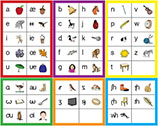
What is the initial teaching alphabet (ITA)?
The initial teaching alphabet (ITA) is a phonetic alphabet that represents the 44 sounds of spoken English. It was designed to give beginning readers a logical and reliable reading and writing system.
When students understand that print is speech written down, that words are made up of speech sounds, that the symbols and the speech sounds agree, they can read anything that they understand. When they know how to form the symbols, they can write anything they can say.
As they become fluent readers and writers in ITA, they become aware of the conventional spellings in traditional orthography. The rest of the words they know they must learn to spell. They become proficient readers and writers without struggling with complex spelling patterns in the beginning stages of literacy development.
initial teaching alphabet (ITA) chart
What are the speech sounds of English?
To hear each speech sound associated with the ITA chart, download the following Powerpoint file and click on the audio buttons.

How does ITA help children at risk of reading failure?
Reading acquisition is much more difficult for many English-speaking children because of the complex sound-spelling system of written English. In ITA intervention programs beginning readers (K-2nd grade) with phonological deficits are tutored to help them:
- Understand how spoken words can be analyzed by counting, adding, substituting or deleting sounds (phonemic awareness)
- Understand how spoken sounds are represented by letters (phonics)
- Spell unknown words by sound, a crucial step in learning to read and spell
How does ITA help remediate reading disabilities in older students?
ITA is very effective for remediation of reading and writing disabilities in older students. In the projects sponsored by the ITA Foundation, tutors use research-validated strategies and ITA reading materials to help students with reading disabilities/dyslexia. These intervention protocols help struggling readers:
- Decode words quickly and accurately through remediation of underlying phonological deficits
- Read fluently using Repeated Oral Assisted Reading (ROAR)
- Increase reading accuracy
- Develop automaticity so that cognitive energy can be devoted to comprehension




